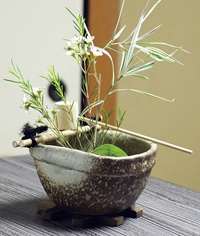Earthenware - Japanese Traditional Culture | TOP
Earthenware

Earthenware is a common ceramic material, which is used extensively for pottery tableware and decorative objects.
Although body formulations vary between countries and even between individual makers, a generic composition is 25% ball clay, 28% kaolin, 32% quartz, and 15% feldspar.
Earthenware is one of the oldest materials used in pottery.
While red earthenware made from red clays is very familiar and recognizable, white and buff colored earthenware clays are also commercially available and commonly used.
Earthenware is commonly bisque, or biscuit, fired to temperatures between 1000 and 1250 °C (1800 and 2100 °F), and glost- (glaze-) fired from 950 to 1,050 °C (1,742 to 1,922 °F).
However examples of the reverse — low biscuit and high glost firing — can also be found: this can be popular with some studio potters where bisque temperatures may be 900 to 1,050 °C (1,652 to 1,922 °F) with glost temperatures in the range of 1,040 to 1,150 °C (1,904 to 2,102 °F).
The exact temperature will be influenced by the raw materials used and the desired characteristics of the finished ware.
The higher firing temperatures are likely to cause earthenware to bloat. After firing, the body is porous and opaque with colours ranging from white to red depending on the raw materials used.
Earthenware may sometimes be as thin as bone china and other porcelains, though it is not translucent and is more easily chipped.
It is also less strong, less tough, and more porous than stoneware, but is less expensive and easier to work.
Due to its higher porosity, earthenware must usually be glazed in order to be watertight.
Copyright© Earthenware All Rights Reserved.
